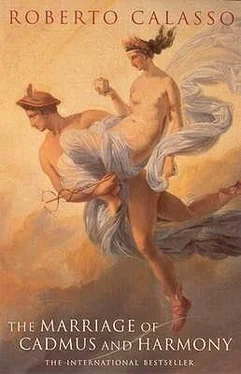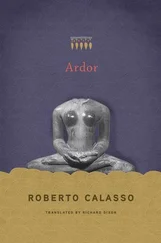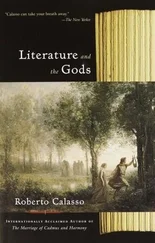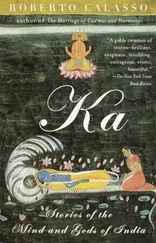Zeus saw two women coming toward him: the Ilithyias, experts in midwifery. Without a word, their hands reached toward his head, gingerly, not daring to touch. Then Hephaestus arrived with a bronze ax. Before Zeus could utter a word, Hephaestus brought the ax down on his head and ran off, followed by the Ilithyias. Why did he run? Zeus still hadn’t said a word. He heard a desperately shrill scream inside his head, like the sound of a Tyrrhenian trumpet.
And all at once he realized he wasn’t alone: with silent steps the other gods had converged on him from all directions. He saw Hera and Hebe, Demeter and Persephone sitting on their baskets, Dionysus lying on a panther skin, thyrsus in hand. And to his other side, Poseidon, Aphrodite, Eros, Apollo, Artemis, Hermes, and the three Moirai, the last apparently confabulating together. All of them were looking at him, but not so as to meet his eyes. They were looking at a point slightly above. Athena had appeared in the crack in his skull, her weapons sparkling, while Nike fluttered around her with a crown in her hand.
Now he could see her too: she had climbed down to the ground and was walking away from her father. Turning her head in silent greeting, she was the only one who looked him in the eyes. Was it his daughter he saw, or his own image gazing back at him? Then Zeus turned to look at the other gods. From the solemn expressions on their faces, it was clear that a new era had begun on Olympus.
Athena was the only being who, at birth, did not grab at something but took something off. Helios’s chariot had stopped in the sky when the goddess emerged from Zeus’s head. The air on Olympus was tense, breathless, as Athena slowly began to strip off her weapons. She put down her shield, her helmet, her javelin; she undid the aegis, and then, just before she slipped off the tunic that hung down to her ankles, a group of Libyan Heroines, clad in red-dyed goatskins thickly decorated with fringes, crowded around to hide her.
Unseen among them, she set off toward Lake Tritonis, in Libya. There she immersed herself in the water, as if to renew a virginity she would never lose. But she had a far deeper intimacy to break away from: the fact that she had been mingled with the body of her father. Athena came out of the water into the dry African air, her body glistening and strong. The Heroines handed her her clothes and weapons one by one. Now Athena could begin her life.

During her African childhood, Athena played at war with Pallas. The two little girls looked almost exactly the same, Pallas’s complexion being just a shade darker. Athena was a guest who had come down from the heavens. Zeus had entrusted her to Triton to bring up. And Triton left her with his daughter Pallas all day. Shut away in their playground, they saw no one else. Violent and brazen, they often came to blows. And they already had their own weapons, child-sized but lethal.
One day they found themselves face to face, spears quivering in their hands. It would have been hard to say who was the mirror of whom. Zeus saw the danger: he threw down his aegis from the sky to form a screen between them. Pallas was dazzled, spear in hand. And a moment later Athena’s spear plunged into her. It was Athena’s first and perhaps her greatest bereavement. Back in Olympus, she decided to fashion a wooden statuette of her dead friend and set it beside Zeus. The image was four cubits high, about the same height as Pallas, with its feet together. When it was finished, Athena covered its breast with the aegis, as though dressing a doll. Then she looked at the statue and recognized herself.
Athena was to slay many a man and monster after this episode, but always knowing exactly what she was doing. One of these victims was a giant who was also called Pallas and who, like other giants, was partly covered by scales and feathers. He claimed to be Athena’s father. He attempted to rape her. So Athena killed him and, with the skill of a woodsman, skinned him from top to toe. She was always on the lookout for scales and feathers: they would go to improve her aegis. But the little girl Pallas, her warrior friend, had prompted the one involuntary action of her life: the action with which she had done to death her own image. What happened that day in Africa was to be Athena’s secret. Few would get to know this story of her childhood.
The Palladium, celestial model for all the statues of antiquity, was conceived as an evocation of a girl who was dead and as the double of a being who was immortal. It carried the mark of uniqueness, partly because it wasn’t fashioned by human hand and partly because Zeus decided to make it the unique guardian of the unique city of Troy. Yet it partook of duplicity from its very conception, and that duplicity would soon begin to work. The primordial image of Athena did not represent Athena, but two other women: Pallas with her spear, and Medusa at the center of the aegis — the friend and the enemy. In each case she was the other, the unique other, separated from Athena thanks only to the screen of the aegis.
For the aegis had been important in Medusa’s story too. On the floor of one of Athena’s temples, Poseidon was licking Medusa’s pearly body, white in the shadows, with his marine saliva. Athena stood before them, a statue in her cell, obliged to watch those two writhing bodies twining together in the silence of her temple. She felt horror at this outrage, and at the same time a deep disquiet, because she knew that Medusa looked very much like herself. So she raised the aegis to annihilate them, to detach herself from them. It was a gesture that rose from Athena’s deepest self, like Artemis’s gesture of drawing her bow. And as, once again, Athena separated herself from everything else behind this screen of scaly skin, the soft filaments of Medusa’s hair, spread out on the floor, began to swell, and already you could see that the tips were turning into so many snakes’ heads.
Ever since the young Ate crashed into the ground there, hurled down by Zeus’s whirling hand, Troy had been the hill of infatuation. But the wooden statuette of Pallas, henceforth to be known as the Palladium, also crash-landed there. Zeus tossed it down in front of Ilus’s tent, so that he would found his city on the hill. Infatuation and the image now lived together in the same place: a city prone to phantoms. And it was to Troy that Helen would come: body or phantom image? That doubt would be drawn out for ten years, then to echo on and on for centuries. Yet the doubt emanated from the statue hidden in Athena’s temple, from the Palladium itself. All the complicated adventures of the Palladium are bound up with the question of the original and the copy.
Long before Plato, there were two disturbing things about the statue: that it might not have been fashioned by human hand, and that it might be only a copy. These two extremes came together in the Palladium. When the Achaeans began their siege of Troy, the Trojans immediately decided to make an identical copy of the Palladium. Thus, if the Greeks managed to steal it, Troy would not fall. Odysseus and Diomedes did break into Athena’s temple and ran off with the Palladium. But, as with every audacious exploit, there are a host of different versions. Was it the real Palladium? Or did they steal two, one real and one false? Or were there, as some suggested, any number of Palladiums, the real one being the smallest? Or were the two Palladiums the two heroes stole both false, the only real one being the one Cassandra clutched in her hand the night Troy was sacked and Ajax dragged her across the floor of Athena’s temple like an old sack? The Athenian version was that, after it had been fought over by all and sundry, it was Theseus’s son, Demophon, who managed to get hold of the statue by pretending to defend a false Palladium from Agamemnon and finally letting him have it, whereas in fact he had already given the real one to Buzyge so that it could be protected in Eleusis.
Читать дальше













